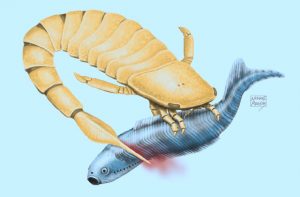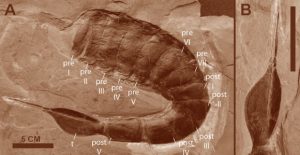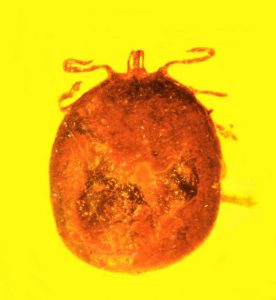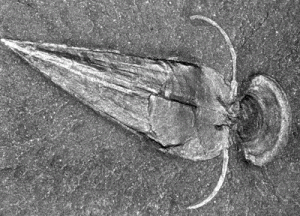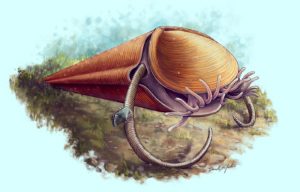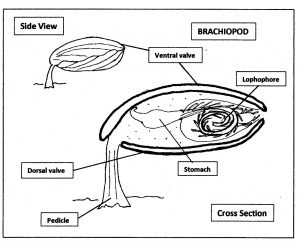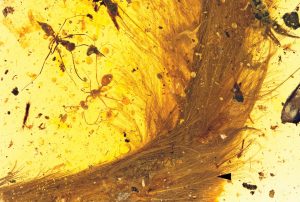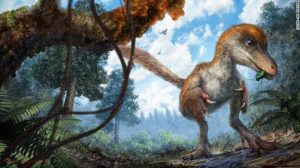Two new studies by two separate teams of paleontologists have been published recently giving new details into the appearance and behavior of everybody’s favourite extinct predator, Tyrannosaurus-rex, better know simply as T-rex.
The first study dealt with the question of whether or not T-rex may have sported a colourful coating of feathers on at least portions of its body. After all T-rex is a member of the line of dinosaurs that paleontologists are convinced are closest to, maybe even ancestors of the birds. There is also growing evidence that T-rex’s smaller relatives were in fact covered in insulating feathers, not flight feathers, insulating feathers to help keep the animal warm. (See my post of 16Dec2016 about a feathered dino tail encased in amber!)
With these facts in mind Professor Phil R. Bell of the University of New England in Australia led a team of researchers to examine all of the available fossil evidence to find an answer. Now because skin impressions of dinosaurs are very rare, especially T-rex, Professor Bell and his colleagues also examined the fossils of T-rex’s close and large relatives such as Albertosaurus, Gorgosaurus and Tarbousaurus.
Based on the evidence they found Professor Bell and his fellow paleontologists have concluded that T-rex and the other large Theropod predators did not possess feathers, not even over portions of their bodies. Like any reptile today, T-rex was covered in scales. Professor Bell theorizes that since large, active animals have more problems with overheating than keeping warm T-rex shed whatever insulation its smaller ancestors may have had. The picture below shows a fossilized impression of the skin of a T-rex.
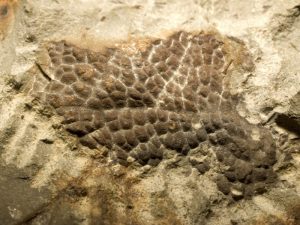
The second study was conducted at the University of Manchester in England and led by Professor William Sellers. Professor Sellers and his team used biometric and biomechanical software programs to study how T-rex would have walked and whether or not T-rex could have run at all as depicted in all those recent Jurassic Park movies. (By the way I hope everyone is aware that T-rex actually lived in the Cretaceous not the Jurassic period!)
Now it a plain fact of nature that as an animal grows larger its weight increases much faster than the strength of its legs. This is why, relatively speaking, the legs of an elephant are considerably thicker than the legs of your dog or cat. Now a T-rex is even heavier than an elephant, and remember T-rex only has two legs on spread its weight on! The possibility that T-rex might have difficulty walking let alone running has to be considered.
Professor Sellers and his colleagues used the latest software biomechanical modeling programs to do just that. Earlier studies had suggested that T-rex might have been capable of speeds as high as 50kph but the new research provided strong evidence that even half that speed would cause ‘unacceptably high skeletal loads’ on the bones in T-rex’s legs.
It appears then that these two recent studies reinforce the picture we had when I was a child of T-rex being a big lumbering reptile. I’m going to try to imbed a short video provided by Professor Sellers and his team showing some of the modeling that they used in their analysis. The link below that will take you to the University of Manchester’s official announcement of the research.
http://www.manchester.ac.uk/discover/news/tyrannosaurus-rex-couldnt-run-says-new-research/
Now, it was just a week ago (15 July 2017) that I posted about my first fossil collecting trip of the year and I’d like to close with a nice little story about keeping your eyes open and maybe you too can make an important fossil discovery.
Jude Sparks, a 10-year old boy who lives in Las Curces, New Mexico was recently playing in his own backyard when he spotted something eroding out of the ground that he thought was the skull of a cow. Doing a little digging Jude quickly realized his skull was too large to be a cow’s. While it was still in the ground, Jude showed what he found to his parents who contacted paleontologists at New Mexico State University.
What Jude had actually discovered was the 1.2 million year old skull of a Stegomastadon, a relative of the more famous Mastodon. The scientists have excavated the skull and hope that more of the animal’s remains may be buried nearby. The picture below shows Jude with his find.
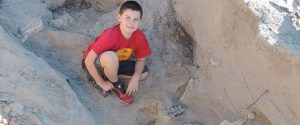
A big part of science is really nothing more than keeping your eyes open and knowing enough to be able to say, ‘Hey, that looks different. I wonder what it is?”

